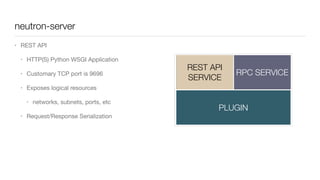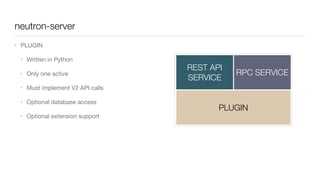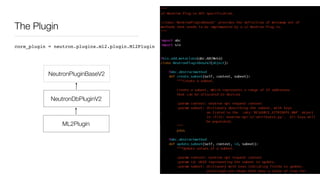Inside Architecture of Neutron
- 1. Inside the Architecture of Neutron Mark McClain mmcclain (at) yahoo-inc.com
- 2. Why Create Neutron? ? Rich Topologies ? Technology Agnostic ? Extensible ? Advance Services Support ? Load Balancing, VPN, Firewall
- 3. The Basics
- 4. What does the user see? Compute API Network API Storage APIGUI, CLI, API Libs KVM ML2 Plugin Ceph
- 5. Abstractions Net1 10.0.0.0/24 Nova Neutron L2 virtual network virtual port virtual server virtual interface (VIF) virtual subnet VM1 10.0.0.2 VM2 10.0.0.2
- 6. Architecture
- 7. Design Goals ? Uni?ed API ? Small Core ? Pluggable Open Architecture ? Extensible
- 8. OpenStack The Operator View
- 9. Basic Deployment neutron-server L2 AgentL2 AgentL2 AgentL2 AgentL2 AgentL2 Agent L3 AgentL3 Agent L3 AgentL3 Agent Database L3 Agent DHCP Agent L2 Agent Message Queue Adv Services
- 10. neutron-server REST API SERVICE RPC SERVICE PLUGIN REST API SERVICE ? REST API ? HTTP(S) Python WSGI Application ? Customary TCP port is 9696 ? Exposes logical resources ? networks, subnets, ports, etc ? Request/Response Serialization
- 11. neutron-server REST API SERVICE RPC SERVICE PLUGIN RPC SERVICE ? RPC Service ? AMQP via Oslo messaging modules ? Enables bidirectional agent communication ? Optional
- 12. neutron-server REST API SERVICE RPC SERVICE PLUGIN ? PLUGIN ? Written in Python ? Only one active ? Must implement V2 API calls ? Optional database access ? Optional extension support
- 13. The Plugin ML2Plugin core_plugin = neutron.plugins.ml2.plugin.Ml2Plugin
- 14. The Plugin NeutronPluginBaseV2 NeutronDbPluginV2 ML2Plugin core_plugin = neutron.plugins.ml2.plugin.Ml2Plugin
- 15. Plugin Extensions ? Add logical resources to the REST API ? Discovered by server at startup ? REST: /v2.0/extensions ? Common Extensions ? Binding, DHCP, L3, Provider, Quota, Security Group ? Other Extensions ? Allowed Addresses, Extra Routes, Metering
- 16. Monolithic Plugin ? Full implementation of core resources ? Two types: ? Proxy ? Direct control PLUGIN
- 17. ML2: Modular Layer 2 Plugin ? Full V2 Plugin Implementation ? Delegates calls to proper L2 drivers ? Two kinds of drivers ? Type Driver ? Mechanism Driver Mech Mgr PLUGIN Type Mgr
- 18. L2 Agent
- 19. L2 Agent ? Runs on hypervisor ? Communicates with server via RPC ? Watch and notify when devices added/removed ? Wires new devices ? Proper network segment ? Security Group Rules
- 20. Dive Into the OVS Agent ? OVS ? What does it actually do? ? How do we get isolation? ? VLAN, Overlays: GRE, VXLAN ? Processing loop
- 21. Linux Network Namespace ? Isolated copy of network stack ? private loopback ? scope limited to namespace ? can reuse addresses ? Explicit con?guration needed to connect ? Processes can spawn within namespace lo eth1 eth0 lo eth1 eth0 lo eth1 eth0 Host A B br-int
- 22. L3 Agents
- 23. Network Node L3 Agent ? Run on Network Node ? Uses Namespaces ? Metadata Agent (if enabled) Network Node Core Hypervisor Hypervisor Hypervisor
- 24. L3 Agent How itĪ»s implemented ? Manages Collection of Network Namespaces ? Isolated IP Stacks ? Forwarding Enabled ? net.ipv4.ip_forward=1 ? Static Routing ? Metadata Proxy lo eth1 eth0 lo qg-2 qr-1 lo qg-b qr-e Host A B br-ex
- 26. Con?guration Agents: DHCP ? RPC based noti?cations ? dnsmasq ? Isolation Support via Network Namespaces ? Multiple copies for HA
- 27. Con?guration Agents: Metadata Proxy ? Proxies Metadata requests to Nova ? Routed Networks ? process embedded in router ? Non-routed Networks ? static route redirects traf?c running in DHCP namespace
- 28. Con?guration Agents: Metadata Proxy curl http://168.254.169.254/openstack/latest/meta_data.json Tenant VM Nova Metadata Service Meta NS Proxy Metadata Agent Unix Domain Socket Management Network X-Router-Id: 2bc7c882-d612-438c-a334-0047f2b5c2d7 X-Forwarded-For: 10.0.0.1 X-Instance-ID: aaaaaaaa-aaaa-aaaa-aaaaaaaaaaaa
- 29. Booting a VM ? nova boot
- 30. Booting a VM ? nova boot ? create port ? notify DHCP of new port
- 31. Booting a VM ? nova boot ? create port ? notify DHCP of new port ? create device ? new in Icehouse wait
- 32. Booting a VM ? nova boot ? create port ? notify DHCP of new port ? libvirt create device ? new in Icehouse wait ? wire port
- 33. Booting a VM ? nova boot ? create port ? notify DHCP of new port ? libvirt create device ? new in Icehouse wait ? wire port ? boot
- 34. Load Balancer as a Service ? Service Plugin ? Driver based ? Agent w/Driver ? Agent communicates over RPC ? Open Source requires namespaces ? Others interact with other systems LB Agent HAProxy
- 35. VPN as a Service ? Service Plugin ? Driver based ? Agent w/Driver ? Communicates over RPC ? Openswan L3 Agent Router Metadata Proxy VPN Driver
- 36. Firewall as a Service ? Edgewall ? Service Plugin ? Driver based ? Agent w/Driver ? Communicates over RPC ? Experimental L3 Agent Router Metadata Proxy Firewall Driver
- 37. Differences ? Different Design Decisions ? Sync with backend system ? L2 Agent Optional ? Not all implement same extensions
- 38. Summary Open vSwitch / Linux Bridge Ryu OpenFlow Controller ? Uni?ed API ? Small Core ? Pluggable Open Architecture ? Multiple Vendor Support ? Extensible
- 39. More Information ? Cloud Administrator Guide ? http://docs.openstack.org/admin-guide-cloud/content/ch_networking.html ? Network v2.0 API ? http://developer.openstack.org/api-ref-networking-v2.html
- 40. Questions?







































